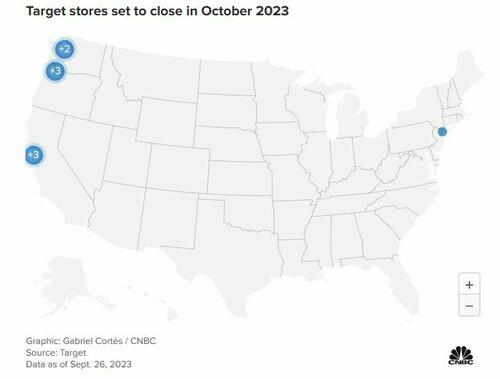Target To Shutter Nine Stores In Major Cities After Being Targeted By Violence, Theft
Retail giant Target on Tuesday announced the closure of nine stores in major cities across the US, citing violence, theft and organized retail crime. The news comes on the heels of a warning from the company that lost or stolen inventory has created a $500 million dent in profitability this year.
“We cannot continue operating these stores because theft and organized retail crime are threatening the safety of our team and guests, and contributing to unsustainable business performance,” the company said in a press statement. “We know that our stores serve an important role in their communities, but we can only be successful if the working and shopping environment is safe for all.”
According to CNBC, the company will close one store in Harlem, two stores in Seattle, three stores in the San Francisco-Oakland Bay Area, and three more in Portland, Oregon.
According to CNBC, Target, which has nearly 2,000 stores in the U.S., has been outspoken about organized retail crime at its stores. It has said theft has driven higher levels of shrink, an industry term used to describe losses from goods that were damaged, misplaced or stolen.
With today’s announcement, Target also stands apart in its decision to both shutter stores and to explicitly blame that decision on retail crime.
When asked in May if the company planned to close stores due to crime, CEO Brian Cornell said “We do not want to close stores. We know how important our stores are. They create local jobs, they generate taxes, they’re very important for those local shoppers, and they play a critical role in communities across the country.”
“We’ll continue to do everything in our power to keep our doors open,” he added. “At the same time, we’ll be closely monitoring the safety of our team and guests as well as the financial impact to our business as we determine the right path forward at Target.”
Target also noted in its Tuesday release that the company supports the passage of the ‘Combating Organized Retail Crime Act,’ which proposes stiffer penalties for theft offenses, and calls for a change in the threshold which must be met by prosecutors before bringing federal theft cases. The Act would also provide retailers with a formal venue to trade information with each other, and law enforcement, through a proposed Organized Retail Crime Coordination Center.
Nine states have passed similar laws since 2022 (six so far this year), which have been supported by retailers and trade associations.
This goes way beyond just crime…
Target’s plight uncovers more layers of operational decay. The company’s struggles, spanning over a year, include an alarming buildup of unsold inventory, backlash against its Pride merchandise collection, and an evident pullback in consumer expenditure on non-essential items such as apparel and home goods.
In an uncharacteristic admission during an earnings call in August of last year, the company – alongside other retailers, highlighted the unexpected blow to profits caused by higher markdowns, along with desperate attempts to offload unpopular merchandise. A surge in inventories predictably correlates with a rise in shrink, leaving a dent in the retail margins, a situation previously unmentioned by Target in the last two decades.
Meanwhile, the introduction of locked cases for merchandise, hiring of third-party guard services, extensive training for store leaders in de-escalation tactics, and considerable investment in cyber defense to counteract fraud and organized crime have failed to make a meaningful difference.
“Despite our efforts, unfortunately, we continue to face fundamental challenges to operating these stores safely and successfully,” the company said in the release.
Target’s announcement, aligning with the release of the National Retail Federation’s latest National Retail Security Survey, sheds light on the nebulous shrink data. Despite a surge to $112 billion in 2022 from $93.9 billion the previous year, the shrink impact on retail bottom lines mirrors past patterns, with an average annual increase from 1.44% in 2021 to 1.57% in 2022.
In the wake of store closures across major cities, Target joins the ranks of Walmart, Nordstrom, and Walgreens Boots Alliance, which are all experiencing similar pain.
Tyler Durden
Tue, 09/26/2023 – 17:45
via ZeroHedge News https://ift.tt/8aMmfQo Tyler Durden

